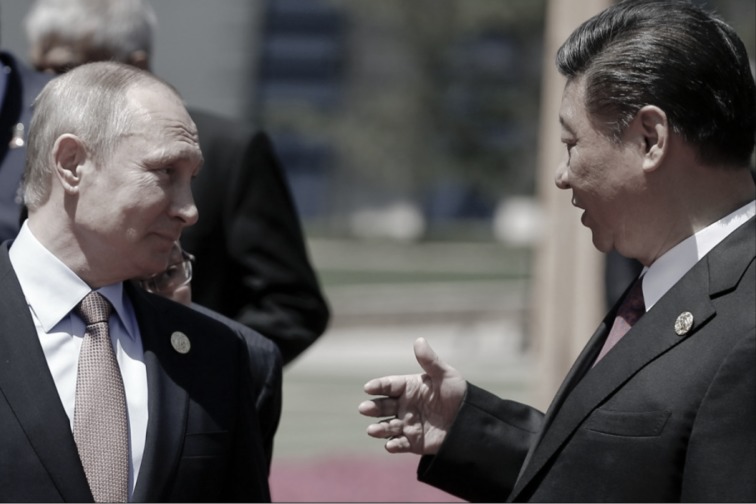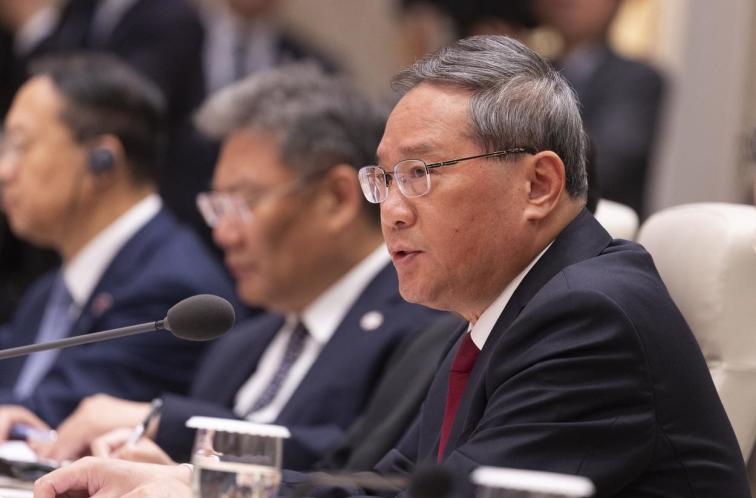Chinese leader Xi Jinping recently attended the APEC Summit, where, during the leaders' group photo session, he stood alone at the centre of the stage, with no one approaching him for conversation, appearing visibly desolate. (Video screenshot)
[People News] The BRICS leaders' meeting in Brazil took place on July 6 and 7, with Chinese Premier Li Qiang attending in place of Xi Jinping. Beijing explained that Xi Jinping's schedule conflicted with the summit, while external speculation suggests he had more pressing matters to address. What significant commitments could have led to Xi Jinping's absence from a meeting he has never missed? On July 7, the Chinese Communist Party's Xinhua News reported that Xi Jinping was conducting an inspection in Yangquan City, Shanxi Province.
This marks the first time Xi Jinping has missed a BRICS meeting. On July 7, Sanli News Network cited an analysis from CNN, which pointed out that Xi Jinping's absence does not indicate a lack of importance placed on the BRICS nations. In the context of the China-U.S. trade war, China is facing serious economic challenges, and Xi Jinping may need to hold crucial political meetings to establish development strategies for the next five years.
As discussions about Xi Jinping's absence from the BRICS meeting continued, he was seen in Yangquan City, Shanxi on the 7th. A report from the Beijing correspondent noted that Xi Jinping inspected the Yangquan Valve Company to gain insights into the industrial transformation in Shanxi.
Additionally, Xinhua reported that Xi Jinping visited the Monument Square of the Hundred Regiments Offensive and toured the Hundred Regiments Offensive Memorial Hall.
On July 8, Xinhua's 'Learning in Progress' published an article reflecting on the various inspections Xi Jinping has conducted in Shanxi since taking office.
According to reports, Shanxi is the first province-wide, comprehensive pilot zone for national resource-based economic transformation in mainland China, adopting an all-encompassing and systematic approach. Since the 18th National Congress, Xi Jinping has visited Shanxi several times for research, expressing high expectations for its development. He hopes that Shanxi can pioneer a new path in its transformation and development.
The report notes that Xi Jinping conducted research visits to Shanxi in July 2017, May 2020, and October 24, 2023, where he examined various cases of transformation and development firsthand.
Additionally, the article recalls that on June 21, 2017, Xi Jinping visited the Jin-Sui Border Area Revolutionary Memorial Hall in Xing County, Lüliang City, Shanxi. On January 26, 2022, he inspected Duan Village in Sengnian Town, Fenxi County, Linfen City, Shanxi. In July of the same year, he returned to Shanxi for further research, visiting the standardized organic daylily planting base in Yunzhou District, Datong City.
In fact, the topic of "energy transformation" has been relevant to Shanxi for the past 20 years. During this period, coal enterprises in Shanxi have undergone several transformations.
In April, the mainland media outlet Nanfengchuang published an article discussing "Shanxi's industrial transformation." The article highlighted adjustments made due to the depletion of coal resources, reforms aimed at reducing the workforce while increasing efficiency, and business restructuring and employee reassignment resulting from corporate mergers. Today, in light of the "dual carbon" goals, Professor Jia Hepeng and Associate Professor Pan Yeheng from the School of Media at Soochow University have observed a sense of transformation fatigue among many residents of Shanxi.
Among those interviewed, an elderly woman who retired from a coal company and resides in a coal community expressed her exhaustion with the ongoing transformations, stating: "There have been too many changes over the years, and we simply can't keep up. We don't understand concepts like climate change and low carbon, but there must be a rationale behind what the government is asking us to do. We just hope that in the end, the transformation doesn't leave us confused about what has transpired and that a group of people doesn't end up losing their stable jobs."
At a large state-owned coal enterprise in Shanxi, a mid-level manager shared with Jia Hepeng: "Our unit has undergone numerous transformations, adjustments, and reforms. Each time, they present it well and introduce many regulations, but ultimately, the decisions are made by the leaders, and the criteria for these decisions are never disclosed. Friends and relatives of the leaders always seem to retain their jobs during these transitions, or even get promoted to better positions. This creates a sense of unfairness among everyone."
Jia Hepeng referenced a 2024 study from the School of Urban and Environmental Sciences at Peking University, informing Southern Wind Window: "Only 11%-14% of current coal power plant employees are expected to successfully transition to new energy jobs by 2060. To secure these positions, they will need to relocate an average of 194 kilometres. While the rapidly expanding new energy sector does offer new job opportunities, it remains to be seen whether the number of available positions can adequately offset the job losses in the coal industry."
It appears that China's economy will continue to experience sluggishness in 2025, a sentiment that seems widely accepted by external observers.
Media commentator Duolun Tuo Fanglian noted that in the first half of 2025, the Chinese economy showed no significant improvement in areas such as deflation, the real estate crisis, youth unemployment, and a sluggish private sector, instead indicating a trend of further deterioration. Although the government has attempted to stimulate the economy through subsidies, interest rate cuts, and infrastructure investments, the results have been limited, revealing the constraints of macroeconomic control measures. Meanwhile, the prevailing optimism in public discourse has obscured the underlying issues, but this false sense of security cannot be maintained in the long run.
Additionally, Radio Free Asia reported that Jiangsu economist Wu Qinxue analyzed the situation, stating that salary reductions in state-owned enterprises, the closure of private businesses, and cutthroat competition among merchants reflect a continuous decline in local financial conditions. He remarked, 'The government lacks the funds to manage people, and the public is reluctant to spend. From salary cuts within the system to the collapse of consumer spending among ordinary citizens, society is quietly forming a top-down 'tightening chain.'
Wu Qinxue believes that the salary cuts for civil servants are merely the beginning; the real issue is that 'the public has lost its consumption drive, businesses have lost confidence in growth, and the entire society's economic imagination is contracting.'
Furthermore, terms like 'involution,' 'deflation,' 'salary cuts,' and 'cautious consumption' appear to have become key descriptors of the current state of the Chinese economy. Wu Qinxue warned, 'If living a 'tight life' is merely a slogan, it can be tolerated; however, if it becomes the norm, or even leads to a situation where there are 'no days to live,' then the resilience and confidence of society will truly face a critical test.'
In May, China's industrial enterprises experienced a substantial decline in profits, as reported by the Central News Agency. Scholar Shen Jianguang attributed this downturn to a lack of effective demand, persistently low prices, and significant overdue payment issues between local governments and businesses. He suggests that in the latter half of the year, downward pressure on China's economy may resurface, leading to increased strain on corporate cash flow.
(Originally published by People News)











News magazine bootstrap themes!
I like this themes, fast loading and look profesional
Thank you Carlos!
You're welcome!
Please support me with give positive rating!
Yes Sure!